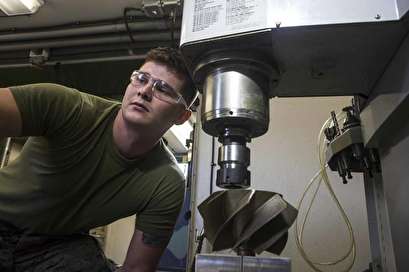TEHRAN, Apr 09- The U.S. Marines' M1A1 Abrams tanks have successfully performed with several 3D-printed impellers.
 TEHRAN, Young Journalists Club (YJC) -The Marine Corps Systems Command and other organizations reviewed the performance of impellers used on the tanks at Twentynine Palms, Calif., last December and January, according a Marines news release Thursday.
TEHRAN, Young Journalists Club (YJC) -The Marine Corps Systems Command and other organizations reviewed the performance of impellers used on the tanks at Twentynine Palms, Calif., last December and January, according a Marines news release Thursday.
After about 100 hours of testing on Abrams tanks during these exercises in Camp Pendleton in California, Marines at Twentynine Palms disassembled the impellers to check for unusual wear, leakage or other problems. None existed.
The Marines, like other military branches, see 3D printing as a quicker way replace worn-out original parts and spare the expense of creating special orders
"Call it a spare tire or a stop-gap solution,"Joseph Burns, technical lead for MCSC's Advanced Manufacturing Operations Cell, said in a news release. "This can get you through a mission, through your training exercise or whatever may be critical at the time."
On tanks, an impeller expels dust from the engine to keep the filters clean. But when the part begins to wear and tear, it might not pull enough air to function properly and reduce effectiveness.
A few years ago, Defense Logistics Agency did not have enough impalers to satisfy all orders with the Marine Corps and the Army.
"At certain times, logistical issues can occur," said Tony Delgado, research and development program manager for additive manufacturing at DLA. "Sometimes, the part is not available right away or something happens with a vendor and a part cannot be provided immediately. This was one of those times where the part wasn't available."
And it can take from six to 10 months for the Marines to receive a part.
"Around that time, the Marine Corps had been provided with 3D printing additive manufacturing tools," Burns said. "And Marines were being encouraged to be innovative and develop prototype solutions to real-world problems. A young Marine identified the impeller and began exploring ways to 3D print this part."
MCSC collaborated with Johns Hopkins University's Applied Physics Laboratory and DLA to check the the performance of the 3D printed impeller.
"Right now, we don't see any reason why the 3D-printed impeller is any less reliable than the OEM version," Burns said. "We plan to continue to collect operational hours on three 3D-printed impellers to better assess the long-term reliability of the part."
Source: upi
 TEHRAN,
TEHRAN,